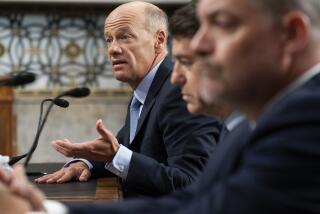Gray Accuses Some S&Ls; of Seeking a ‘Taxpayer Bailout’
- Share via
WASHINGTON — Some leaders of the troubled savings and loan industry want a “taxpayer bailout” costing billions of dollars, the chairman of the Federal Home Loan Bank Board charged Thursday in a bitter exchange with the business he regulates.
Chairman Edwin J. Gray’s assertion “is absolutely false,” the U.S. League of Savings Institutions said in a statement circulated at the congressional hearings where Gray made his charges.
The argument centers on the best way to preserve the federal insurance fund that guarantees savings and loan association deposits up to $100,000.
Cash and securities in the fund “have fallen to critically low levels,” Gray told the oversight subcommittee of the House Energy and Commerce Committee. He wants Congress to allow the sale of $15 billion in bonds to bolster the fund, operated by the Federal Savings and Loan Insurance Corp. These bonds, plus premiums collected from the industry, provide the cash that the FSLIC uses to pay off depositors at failed institutions.
“The real issue is who is going to pay--the industry or the taxpayers,” Gray said in an interview after the hearing. “I am very unpopular for saying this; it’s the truth.”
If the insurance fund is exhausted, the federal Treasury then will pay off depositors from failed institutions, Gray noted. Congress voted in 1982 to put the “full faith and credit” of the nation behind the federally insured deposits.
This was, in effect, a blank check on the Treasury to reassure depositors. And Gray says that this check will be cashed unless Congress adopts his plan to expand the insurance fund.
Federal insurance “was designed to protect depositors,” said Gray. “I now see it being perverted into a system designed to protect, yes, shield, the officers and owners of thrifts from economic loss, even at the cost of a taxpayer bailout in the future.”
But the savings and loan industry argues that the situation is far less threatening. “The savings institution business has always advocated using its own money” to help the insurance fund, William B. O’Connell, president of the U.S. League, said in a statement Thursday. The Senate has passed a bill calling for the sale of $7.5 billion in bonds to recapitalize the insurance fund, while the House Banking Committee voted for $5 billion. The money would be spent during a two-year period, and then, O’Connell said, “Congress can re-evaluate the situation and authorize more money if necessary.”
The industry already spends more than $2 billion a year for premiums to the federal insurance fund, Dennis Jacobe, the U.S. League’s research director, said. For a $10,000 savings deposit, the industry must pay $20 a year for insurance, compared to $8 spent by a bank for insurance with the federal government.
If Gray’s $15-billion bond plan is adopted by Congress, the savings and loan industry “will see no end” to the special premium it is paying the insurance fund, Jacobe said. A big, continuous premium will be needed to pay the interest costs on the bonds, he said.
Gray may be overestimating the losses the fund will have to cover, Jacobe said. “You can’t project interest rates and economic conditions,” he said. “Nobody really knows. If oil prices rise and housing demand goes up, the losses could be less.”
Many of the deeply troubled savings and loan associations are in oil-producing states and agricultural areas that are suffering from severe economic distress.
However, Gray told the subcommittee, it is a “myth that the problems facing the FSLIC are overwhelmingly due to temporarily distressed regional economics. We are urged to do nothing and let time heal the wounds,” he said. “The truth is very different. The massive losses facing the FSLIC, even in Texas, were caused by thrift managers who were reckless or worse.”
The Texas savings and loan associations in the most trouble “were characterized by excessive growth, investment in high-risk assets and excessive dividends,” Gray said.
Lawrence J. White, a member of the Home Loan Bank Board, told the subcommittee that the insurance fund might be forced to spend $20 billion to $25 billion to pay off depositors and “clean out institutions with no hope of turning themselves around.”
Rep. John D. Dingell (D-Mich.), chairman of the oversight subcommittee, was critical of the bank board’s role in the handling of financial reporting by savings and loan associations.
More to Read
Inside the business of entertainment
The Wide Shot brings you news, analysis and insights on everything from streaming wars to production — and what it all means for the future.
You may occasionally receive promotional content from the Los Angeles Times.









